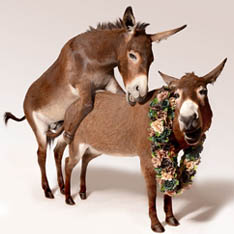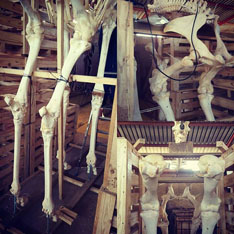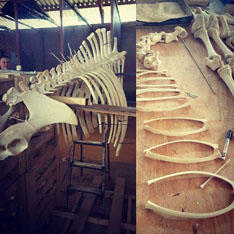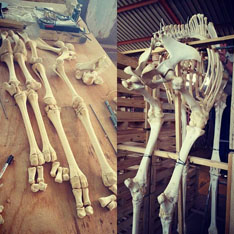AFTER-LIFE, Animal Stories from Beyond
the Grave
The Works explained
After-Life Exhibition at Z Ward Glenside
Read 'Weekend Notes' article
about this echibition>>>
|
The Judas Collar Rod McRae 2015
2 x donkey skins, bone, glass, plastic, steel, high-density foam, copper & fabric
Many introduced animals like Donkeys that are designated ‘Feral’ by Australian authorities forfeit their right to be slaughtered in a humane manner.
The Judas Collar is a GPS device that is strapped to a feral Jenny to lead hunters to any group of wild donkeys she might discover – unfortunately for the herd – this has terrible consequences. The Jenny however is left standing among the carnage to find another group - where upon the cull is repeated.It has been observed in donkeys that the Jenny eventually learns that she is somehow bringing death to her friends. After two or three exterminations she refuses to seek out her own kind, whereupon she is shot and the Judas Collar recycled on another. The Judas collar is also used on so called feral camel, goat, pig, buffalo and dogs, in fact it has proved deadly effective on any socialable species.
This work describes the visceral nature of the animal condition, driven by the need for companionship and the drive to reproduce, the act of sex becomes a potent symbol of freedom, belonging and reproduction – all three notions are subject to constraint in human society but so easily expressed in animal societies. The animal sex act embarrasses our human sensibilities, reminding us we are not free to pursue our own animal urges; but also it underlines our fear of alternate species gaining dominance. We decide which animals can breed and which cannot, domesticated cattle may as they have economic value to us (even though they weigh heavy on the environment) animals without obvious economic value - may not. The Donkey has a potent role in the mythologies of Australia, as a pack animal instrumental in opening up outback Australia (the ancestors of the now wild population), and their sacrifice during World War I, celebrated in the story of Simpson’s Donkey which is hinted at in the camouflage colours of the floral tribute around the Jenny’s neck.
Artist Statement.
AFTER-LIFE, Animal Stories from Beyond the Grave.
As the name suggests this new body of work continues my exploration of animal –human relationships commenced with Wunderkammer, the Cabinet of Wonders back in 2010.
If Wunderkammer was a broad survey of the animal condition, AFTER-LIFE attempts to focus down on what it means to be wild, free and autonomous verses domesticated and farmed.
The animals (all ungulates – hoofed or cloven) in AFTER-LIFE have either been born in the service of man or are perceived to be such.
Harvested by his hand in the slaughter house, (goats), knackers yard (donkeys and horse) and in the fields that some mistake as wilderness - but are in fact fenced places where animals might wander masquerading as free, (Giraffe and Antelope). Some are taken for their constituent parts –meat, bone, antler, skin, hair and organs, whilst others, like the donkeys that were once used to explore the Australian continent are now sadly designated ‘feral’ affording them a ‘shoot and discard’ status.
All these animals suffer from the same core human value – one of possession. These ungulates all appear to exist for the sole purpose of man, their individual rights forfeited in favour of invasive manipulation practices in their selection and breeding and subsequent management to slaughter.
The Animals in AFTER-LIFE speak to us as an unrepresented slave class, bred, traded, worked, slaughtered, processed and consumed as part of a vast production machine to fed, dress and decorate exploding homo-sapien populations - these are their stories.
Disclaimer.
All the animals in AFTER-LIFE have been ethically sourced. No animal has been harmed to make this work in the first instance; the skins and the skeletons are the result of death by natural causes, medical euthanasia, hunting, culling and food production and have been traded on, sometimes multiple times before they became part of this body of work.
After-Life explained.

1. Goat Stack.
5 domesticated goats stand one on top the other creating a tapering tower tribute to goat agility and sure-footedness.
These male (Billy) goats originated in South Africa, unlike their mothers and sisters (Nanny) goats - whose milk production is valued, most males are removed from their mothers teat soon after birth and quickly fattened for the table.
This work explores the schizophrenic relationship we have with goats, one of cherished pet, milk and meat producer to feral/vermin status.
Each goat wears a collar - each collar tells a story.
1. The Billy Cart Harness was designed to fitted to a strong male goat to pull a cart of farm materials like firewood or produce to market. In more recent times the harness has been employed for Billy Goat Cart racing usually with children as the jockeys. This is almost certainly where the term ‘Billy Cart’ came from which is so readily recognized in Australia – (minus the goat). The harness reminds us that animals are not always enslaved to us for their ability to produce food, they might also be in possession of great strength or agility sealing their usefulness.
2. The Judas Collar is a radio-telemetric GPS device designed to track down groups of ‘feral’ animals. Collars like this have seen service across rural Australia where ‘feral’ animals are portrayed to be in competition with farmed species creating an economic threat to the farmer’s livelihood. In this case the Judas Collar is attached to a captured feral female goat, she is then set free to search out her own kind, this in turn leads the hunters to her new family and the inevitable destruction of the group leaving her the only individual standing ready to repeat the task.
3. This Birch Yolk, is a simple yet beautifully fashioned collar from 18th Century Belgium and was worn by an individual member of the diary goat herd to assist with handling. This hand made collar comes from a time when each goat was a valued member of the diary herd.
4. The Fetish Collar, a playful addition - often associated with dog collars, or a satanic image made all the more potent with the unsympathetic eyes, narrow head and horns of the goat. Unfortunately down through the centuries, goats have often been associated with the image of the devil.
5. The Bell Collar is a gentle symbol for domesticated bliss, a bucolic reminder before factory farming where each animal had a name and was valued as an individual rather than as a number in a vast productive herd.

2. The Trojan Horse
The Trojan Horse is a tale from the Trojan War about the subterfuge that the Greeks used to enter the city of Troy and win the war. In the canonical version, after a fruitless 10-year siege, the Greeks constructed a huge wooden horse, and hid a select force of men inside. The Greeks pretended to sail away, and the Trojans pulled the horse into their city as a victory trophy. That night the Greek force crept out of the horse and opened the gates for the rest of the Greek army, which had sailed back under cover of night. The Greeks entered and destroyed the city of Troy, decisively ending the war. from Wikipedia.
In peace, and in war. For personal transport, haulage, plowing and the turning of the mill. In sport pulling the chariots in the Circus of Rome and on the contemporary racecourse, steeple chase and at the trots. In entertainment in Rodeo and wild west shows, show-jumping and dressage, trekking and horse rides, and for its constituent parts for glue, apparel, and meat production. The man-horse relationship has been a long and sacrificial one for the horse.

3. The Lucky Panda Bone House
This work consists of a small greenhouse housing 200kg of animal bones stacked to overflowing representing a myriad of different species. The bones are tied in auspicious red and yellow twine and ribbon favoured by the Chinese. This work illustrates the over 1500 different animal species employed in the production of Traditional Chinese Medicine. This fast growing trade is threatening some species with extinction.

4. Marius
On the 9th February 2014 a healthy young male giraffe named Marius was slaughtered at Copenhagen zoo and dissected in a public spectacle because he was considered genetically unsuitable for breeding. His remains were later fed to the big cats. This event created outrage in social media - in fact prior to his execution several other zoos offered to take the young giraffe but Copenhagen refused all offers of relocation without giving a compelling explanation.
Marius’s demise begs the question - why do zoos breed genetically redundant specimens in the first place - could it be an economic decision to feed the box office using the appeal of baby animals?

5. The Judas Collar
Many introduced animals like Donkeys that are designated ‘Feral’ by Australian authorities forfeit their right to be slaughtered in a humane manner.
The Judas Collar is a GPS device that is strapped to a feral Jenny to lead hunters to any group of wild donkeys she might discover – unfortunately for the herd – this has terrible consequences. The Jenny however is left standing among the carnage to find another group - where upon the cull is repeated.
It has been observed in donkeys that the Jenny eventually learns that she is somehow bringing death to her friends. After two or three exterminations she refuses to seek out her own kind, whereupon she is shot and the Judas Collar recycled on another. The Judas collar is also used on so called feral camel, goat, pig, buffalo and dogs, in fact it has proved deadly effective on any socialable species.
This work describes the visceral nature of the animal condition, driven by the need for companionship and the drive to reproduce, the act of sex becomes a potent symbol of freedom, belonging and reproduction – all three notions are subject to constraint in human society but so easily expressed in animal societies. The animal sex act embarrasses our human sensibilities, reminding us we are not free to pursue our own animal urges; but also it underlines our fear of alternate species gaining dominance. We decide which animals can breed and which cannot, domesticated cattle may as they have economic value to us (even though they weigh heavy on the environment) animals without obvious economic value - may not. The Donkey has a potent role in the mythologies of Australia, as a pack animal instrumental in opening up outback Australia (the ancestors of the now wild population), and their sacrifice during World War I, celebrated in the story of Simpson’s Donkey which is hinted at in the camouflage colours of the floral tribute around the Jenny’s neck.
|





